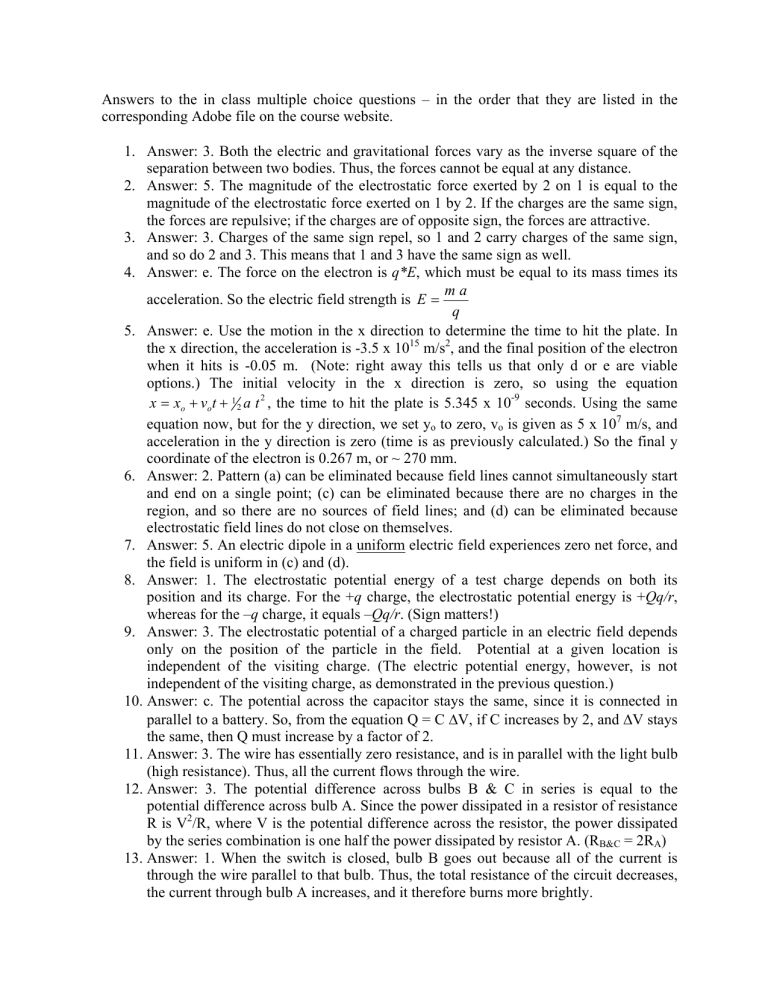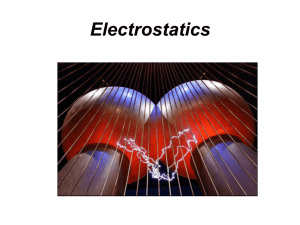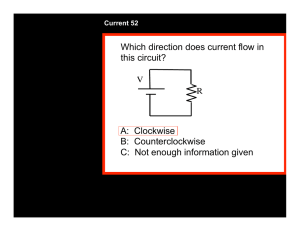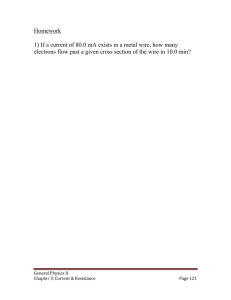Answers to the in class multiple choice questions – in the order that

Answers to the in class multiple choice questions – in the order that they are listed in the corresponding Adobe file on the course website.
1.
Answer: 3. Both the electric and gravitational forces vary as the inverse square of the separation between two bodies. Thus, the forces cannot be equal at any distance.
2.
Answer: 5. The magnitude of the electrostatic force exerted by 2 on 1 is equal to the magnitude of the electrostatic force exerted on 1 by 2. If the charges are the same sign, the forces are repulsive; if the charges are of opposite sign, the forces are attractive.
3.
Answer: 3. Charges of the same sign repel, so 1 and 2 carry charges of the same sign, and so do 2 and 3. This means that 1 and 3 have the same sign as well.
4.
Answer: e. The force on the electron is q*E , which must be equal to its mass times its acceleration. So the electric field strength is E = m q a
5.
Answer: e. Use the motion in the x direction to determine the time to hit the plate. In the x direction, the acceleration is -3.5 x 10 15 m/s 2 , and the final position of the electron when it hits is -0.05 m. (Note: right away this tells us that only d or e are viable options.) The initial velocity in the x direction is zero, so using the equation x = x o
+ v o t +
1
2 a t 2 , the time to hit the plate is 5.345 x 10 -9 seconds. Using the same equation now, but for the y direction, we set y o
to zero, v o
is given as 5 x 10 7 m/s, and acceleration in the y direction is zero (time is as previously calculated.) So the final y coordinate of the electron is 0.267 m, or ~ 270 mm.
6.
Answer: 2. Pattern (a) can be eliminated because field lines cannot simultaneously start and end on a single point; (c) can be eliminated because there are no charges in the region, and so there are no sources of field lines; and (d) can be eliminated because electrostatic field lines do not close on themselves.
7.
Answer: 5. An electric dipole in a uniform electric field experiences zero net force, and the field is uniform in (c) and (d).
8.
Answer: 1. The electrostatic potential energy of a test charge depends on both its position and its charge. For the + q charge, the electrostatic potential energy is + Qq/r , whereas for the – q charge, it equals – Qq/r . (Sign matters!)
9.
Answer: 3. The electrostatic potential of a charged particle in an electric field depends only on the position of the particle in the field. Potential at a given location is independent of the visiting charge. (The electric potential energy, however, is not independent of the visiting charge, as demonstrated in the previous question.)
10.
Answer: c. The potential across the capacitor stays the same, since it is connected in parallel to a battery. So, from the equation Q = C ∆ V, if C increases by 2, and ∆ V stays the same, then Q must increase by a factor of 2.
11.
Answer: 3. The wire has essentially zero resistance, and is in parallel with the light bulb
(high resistance). Thus, all the current flows through the wire.
12.
Answer: 3. The potential difference across bulbs B & C in series is equal to the potential difference across bulb A. Since the power dissipated in a resistor of resistance
R is V 2 /R, where V is the potential difference across the resistor, the power dissipated by the series combination is one half the power dissipated by resistor A. (R
B&C
= 2R
A
)
13.
Answer: 1. When the switch is closed, bulb B goes out because all of the current is through the wire parallel to that bulb. Thus, the total resistance of the circuit decreases, the current through bulb A increases, and it therefore burns more brightly.





